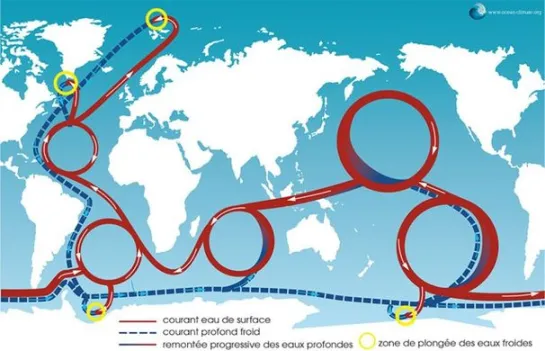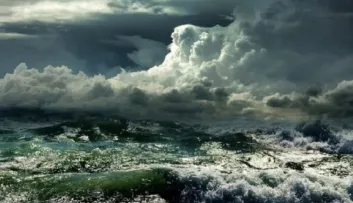The Ocean and the Climate 4mn
Marine currents, the regulators of the climate
Life on Earth cannot exist without the ocean.

A natural thermal machine
Life on Earth cannot exist without the ocean
Every other breath is made possible by the oxygen produced by oceanic plant plankton. The ocean, the gigantic volume of water in perpetual motion that covers 71% of the globe, determines the climatic conditions that prevail on the Earth's surface. The ocean has absorbed about 25% of the CO2 emitted into the atmosphere by human activities. By absorbing and storing the main greenhouse gas, the ocean is playing a fundamental role in regulating the climate.

The ocean and the atmosphere together form a gigantic natural thermal machine. In effect, the ocean and the atmosphere are constantly exchanging gases, water and heat, which the ocean redistributes around the globe through marine currents.
These exchanges determine the climate around the world.
Hot / cold in the ocean
The ocean warms by absorbing solar energy and cools by evaporation and by releasing heat into the atmosphere.
However, as water has a high thermal inertia, it heats up and cools down very slowly. This means that the world's oceans store enormous quantities of heat that they release over very long periods of time.
Heat is redistributed across the planet by powerful currents that flow from the bottom to the surface and from one region to another.
The flow of the ocean currents, the "rivers" of the seas
Marine water moves between the equator and the polar regions, and between the surface and the depths. Vast masses of water are pushed by the currents, which create immense "rivers" in the sea.
These oceanic movements, whether horizontal or vertical, are determined by:
- the winds,
- forces related to the rotation of the Earth
- and differences in density or temperature between the bodies of water.

Through the surface currents, the heat accumulated by the sea in the tropics will warm up the polar zones, thereby reducing the differences in temperature.
In the North Atlantic, the Gulf Stream carries heat from the tropics to Europe. It then splits into two branches that flow northwards where the water cools. Sea ice forms and salt is released into the seawater.
These waters are more salty, colder and denser and sink to the bottom. They then flow back towards the equator and after a long journey around the planet, they come back up to the surface.
The waters only sink to the depths in some very specific points around the globe, which are mainly located in the North Atlantic and the Southern Ocean. The largest source is situated in the North Sea, between Greenland and northern Europe.
The role of Antarctica
Antarctica also plays an important role. Along the coasts, near Adelie Land, there is an area without any ice where warmer water flows upwards, exchanges heat and forms cold water that sinks to the bottom.
The Antarctic Circumpolar Current (ACC), which is the most powerful, largest and fastest moving current on the planet, agitates the waters of three oceans: the Atlantic, Indian and Pacific. It is 20,000 km long, 200 to 100 km wide and can go down to depths of 4,000 m. It carries 130 million m3 per second and has a surface speed of 0.9 to 3.7 km/h.
Due to its geographical position and the particularities of the ACC, the Southern Ocean plays a major role in ocean circulation around the globe and in climate regulation.
And what happens if the currents change?
Changes in water temperature and salinity (as land and polar ice melts) affect the density of the water masses, which could slow the descent of cold waters into the deep sea. The marine currents could be affected.
Changes in current and wind patterns can cause climatic disturbances such as severe storms.
In its latest Special Report on the Ocean and Cryosphere in a Changing Climate, published in 2019, the IPCC warns that melting ice and rising temperatures are altering the workings of ocean currents, which have an extremely long global cycle.
In particular, the slowing of the North Atlantic Current reduces marine productivity, causes winter storms in Europe, and reduces rainfall in the Sahel and South Asia.


